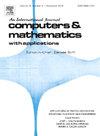Kernel-based collocation methods with TBC for the elastic wave scattering by obstacles
IF 2.5
2区 数学
Q1 MATHEMATICS, APPLIED
引用次数: 0
Abstract
Elastic wave scattering plays a crucial role in medical imaging, seismic exploration, and non-destructive testing. In this paper, the kernel-based collocation methods are constructed for elastic wave scattering problems by multiple obstacles. Using Helmholtz decomposition, the original Navier equations for elastic waves in unbounded domain are reformulated into a Helmholtz equation system with two potential functions, coupled on the obstacle boundaries. To handle the unbounded domain, the transparent boundary conditions (TBC) are built based on the Dirichlet-to-Neumann (DtN) operator. The proposed method employs a kernel-based collocation method that combines radial basis functions (RBFs) with a weighted least-squares (WLS) method. The WLS formulations are proposed by setting more collocation points than trial centers and adding weights with respect to fill distance of collocation sets at obstacle and TBC boundary collocation terms. Using Whittle-Matérn-Sobolev kernels with kernel smoothness m, numerical experiments demonstrate that the proposed method can obtain solutions with the expected convergence rate for elastic scattering involving both single and multiple irregular obstacles. Furthermore, compared with the Kansa method and other mesh-dependent methods, the proposed method offers higher accuracy and more stable solutions for relatively large angular frequencies.
障碍物弹性波散射的TBC核配点法
弹性波散射在医学成像、地震勘探和无损检测中起着至关重要的作用。本文针对多障碍物的弹性波散射问题,建立了基于核函数的配置方法。利用亥姆霍兹分解,将无界区域弹性波的原始Navier方程重新表述为具有两个势函数的亥姆霍兹方程组,并在障碍物边界上耦合。为了处理无界域,基于Dirichlet-to-Neumann (DtN)算子建立了透明边界条件(TBC)。该方法采用基于核的径向基函数(rbf)和加权最小二乘(WLS)相结合的配点法。通过设置比试验中心更多的搭配点,并在障碍和TBC边界搭配项处增加搭配集填充距离的权值,提出了WLS公式。采用核平滑度为m的whittle - mat - sobolev核进行数值实验,结果表明,该方法对于包含单个和多个不规则障碍物的弹性散射都能以预期的m−2收敛速率获得解。此外,与Kansa方法和其他依赖网格的方法相比,该方法在较大的角频率下具有更高的精度和更稳定的解。
本文章由计算机程序翻译,如有差异,请以英文原文为准。
求助全文
约1分钟内获得全文
求助全文
来源期刊

Computers & Mathematics with Applications
工程技术-计算机:跨学科应用
CiteScore
5.10
自引率
10.30%
发文量
396
审稿时长
9.9 weeks
期刊介绍:
Computers & Mathematics with Applications provides a medium of exchange for those engaged in fields contributing to building successful simulations for science and engineering using Partial Differential Equations (PDEs).
 求助内容:
求助内容: 应助结果提醒方式:
应助结果提醒方式:


